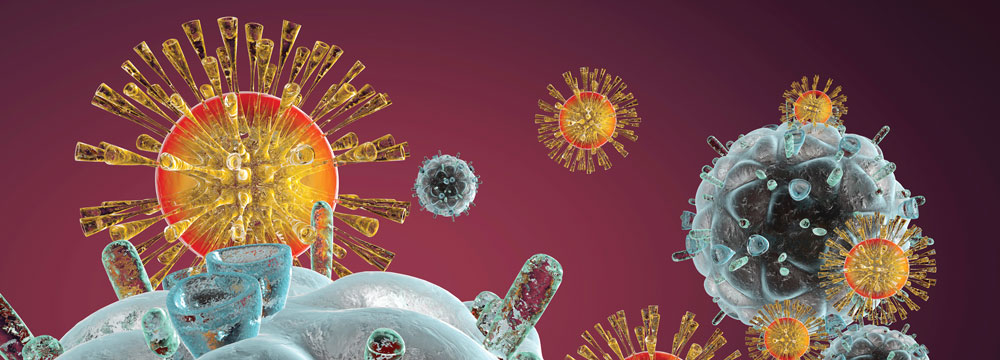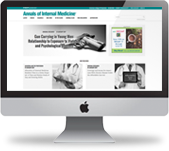
Living a longer life with HIV
As HIV increasingly transforms into a chronic condition, internal medicine physicians can focus more on reducing cardiovascular conditions and other age-related diseases.
As HIV increasingly transforms into a chronic disease, internal medicine physicians can focus more on reducing cardiovascular conditions and other age-related diseases, bolstered by a recent battery of studies and other updated guidance.
An estimated 1.2 million adolescents and adults in the U.S. are living with HIV, and four out of 10 are at least 55 years old, according to federal data. Meanwhile, medication advances continue to promote viral suppression, and with treatment, two-thirds of diagnosed individuals live with their virus at undetectable levels.
But while the survival gap has narrowed over time, people with HIV are still more likely to develop other chronic conditions sooner than those without the virus, according to an analysis published in 2020 in JAMA Network Open. Even when patients were prescribed antiretroviral treatment early, when CD4 cell counts were 500 cells/μL or greater, they were more likely to be diagnosed with at least one of six chronic conditions—liver disease, kidney disease, lung disease, diabetes, cancer, or cardiovascular disease—nearly a decade earlier.
Recently, a key study highlighted the need for a more aggressive approach to cardiovascular prevention in this population, according to a 2024 primary care guidance update by the Infectious Diseases Society of America (IDSA), published Oct. 12, 2024, in Clinical Infectious Diseases. That update, the first since 2020, covers the gamut of management, including cancer screening and immunizations, medication guidance, and prophylaxis to prevent other sexually transmitted infections (STIs).
In the modern era, medication can suppress HIV to undetectable levels in most patients with just one to two pills daily, said Paul Sax, MD, clinical director of the division of infectious diseases at Brigham and Women's Hospital in Boston and a professor of medicine at Harvard Medical School. He noted that internal medicine physicians, given their broad expertise, are well situated to care for the bulk of these stable patients, working with an HIV specialist: “If you have someone who is over 70 years old and has hypertension and diabetes and terrible arthritis and all of the various ailments of aging, HIV is the least of their problems.”
‘Practice-changing’ prevention
Patients with HIV are prone to cardiovascular disease, facing roughly twice the risk compared with the general population, according to a global meta-analysis of 80 studies published in 2018 in Circulation. While the precise reasons are still being understood, some factors may include higher rates of elevated cholesterol and insulin resistance, along with chronic inflammation associated with HIV infection.
A recent study—described as “practice-changing” by the IDSA authors—demonstrated that statins can provide protection starting as young as age 40 years in adults with HIV and low to moderate cardiovascular risk. Researchers halted the study, called the Randomized Trial to Prevent Vascular Events in HIV (REPRIEVE), early due to the benefits. In the group taking pitavastatin, major adverse cardiovascular events were reduced by 35% versus the placebo group, according to the findings, published Aug. 24, 2023, in the New England Journal of Medicine. Nearly one-third of the 7,769 participants, who ranged in age from 40 to 75 years, were female, and the preventive benefit appeared similar in both men and women.
The cardiovascular benefit likely applies to other statins, the IDSA authors wrote. Unless there are contraindications, they recommend starting a statin for all HIV-positive individuals at age 40 years, particularly those with a 10-year cardiovascular risk score of 5% or higher.
“The study was pretty powerful—it worked,” said Eric S. Daar, MD, FACP, chief of the division of HIV medicine at Harbor-UCLA Medical Center in Torrance, Calif., and a professor of medicine at the David Geffen School of Medicine at UCLA. “Patients with HIV are at higher [cardiovascular] risk even when their virus is suppressed, and their T-cells are high.”
Convincing someone in their early 40s with a risk score below 5% to start taking a statin may be a tougher sell, Dr. Daar said, but it's worth making the case. “I tell them that the side effects [of statins] are relatively rare and are reversible,” he said. “And there's clearly a benefit, although the real benefit is small in those with a risk score below 5%. As a result, I prefer to spend most of my energy on those with a greater than 5% risk score.”
Cancer screening savvy
Even so, cardiovascular disease doesn't pose the greatest threat to people with HIV, as it does for adults without the virus, Dr. Sax pointed out. He cited a recent analysis, based on a Swiss database, which found that 22.9% of HIV-positive individuals died of non-AIDS-related cancers between 2005 and 2022, far more than the 9.7% who died of cardiovascular causes. Meanwhile, cardiovascular-related deaths remained relatively stable during that time frame, while non-AIDS-related cancer deaths have steadily increased, comprising 31.1% of all deaths by 2020-2022, according to the findings published on July 15, 2024, in Clinical Infectious Diseases.
Along with higher rates of cancer risk factors, such as smoking, people with HIV appear to be inherently more vulnerable, Dr. Sax said. “Our immune system is constantly looking for cancerous cells and trying to clear them away,” he said. “We have always known that immunosuppression increases the risk of cancer.”
Screening for common cancers, including breast, colon, lung, and prostate, should follow guidelines from the U.S. Preventive Services Task Force and others for the general population, according to the IDSA guidance. But given that patients with HIV are at higher risk, clinicians should be vigilant for cancer, particularly those associated with viruses including Epstein-Barr virus, human papillomavirus (HPV), and hepatitis B and C virus, the authors wrote.
Some additional HIV-specific guidance from the IDSA includes the following:
- Recommendations on cervical cancer screening, including HPV testing and a Pap test, are similar to those for the general population, but there's no age limit for stopping screening.
- Screening for hepatocellular carcinoma with ultrasound is recommended every six months in patients who have cirrhosis, regardless of the underlying cause, as well as in those with chronic hepatitis B or a history of chronic hepatitis C and stage F3 or F4 fibrosis.
- To identify anal cancer, an annual digital rectal exam is recommended. Some populations, including transgender women and men ages 35 years and older who have sex with men, as well as all other people with HIV starting at age 45 years, should be screened with an anal Pap test, as long as they have access to high-resolution anoscopy (HRA) and treatment.
Anal cancer screening
The IDSA anal screening guidance, which aligns with a new federal recommendation issued in 2024, stems from a study showing the benefits of earlier intervention.
Patients whose high-grade squamous intraepithelial lesions were treated after identification with HRA were 57% less likely to develop anal cancer than an active monitoring group, according to the findings, published on June 16, 2022, in the New England Journal of Medicine. Among the nearly 4,500 participants, nine cases of anal cancer were diagnosed in the treatment group and 21 cases were diagnosed in the active monitoring group after a median follow-up of 25.8 months.
But participants had already been diagnosed with high-risk lesions before they were randomized, Dr. Daar pointed out. “It didn't tell us the best way to screen to find those people who have high-grade squamous intraepithelial lesions,” he said.
Moreover, physicians frequently don't have a nearby HRA specialist to whom they can refer patients when abnormalities are identified with an anal Pap test, said Dr. Daar, who put himself in that group. Anal cancer is a horrible disease, he stressed, but even when HRA testing is available, large numbers of patients would have to complete the multistage screening process to prevent one case of anal cancer.
When HRA is available, physicians may consider a shared decision-making approach prior to performing an anal Pap test, Dr. Daar said. They can educate patients about the lack of data on optimal screening strategies and the need for multiple stages, including an anal Pap followed by HRA and biopsy, before determining whether treatment is indicated.
The substantial proportion of people screened will not have high-grade disease and therefore will “go through this procedure for naught,” he said. “But that doesn't mean that it's not the right thing to do for a fully informed person who has access to HRA, recognizing that everybody assumes different amounts of risk in their lives.”
HPV, shingles vaccines
People with HIV are more vulnerable to severe complications from HPV infection, including cervical and anal cancer, Dr. Daar said. Ideally, they would have been vaccinated against HPV as an adolescent, but if not, physicians can offer the HPV vaccine to adults ages 27 to 45 even if they've been sexually active for years. “While we acknowledge that most people have already been infected before then, we don't know if they have been infected by all the serotypes,” he said.
The higher vulnerability of HIV-positive patients to viruses like HPV also provides physicians with an educational opportunity related to smoking cessation, said Elizabeth Kass, MD, a Boston internal medicine physician who has a long-standing interest in HIV care. At least one-third of people with HIV smoke cigarettes, according to the National Cancer Institute.
“I say, ‘Everybody knows about lung disease. Everybody knows about lung cancer. Everybody knows it's bad for your heart. But a lot of people are not aware that it [smoking] is also something that further makes it difficult for your immune system to clear HPV,’” Dr. Kass said.
Other HIV-specific immunization guidance includes the latest shingles vaccine, which is recommended for adults ages 18 years and older—versus starting at age 50 years in the general population—even if someone has already had varicella or shingles. “It's no longer a live vaccine, so we can give it to our patients without concern,” Dr. Daar said. (For more immunization recommendations, consult HIV.gov.)
Additional management strategies
Primary care physicians have a lot to manage, but don't skimp on oral health, said Joseph P. McGowan, MD, FACP, medical director of HIV services at Northwell Health in New Hyde Park, N.Y., and a professor of medicine at Zucker School of Medicine at Hofstra. Physicians can identify not only thrush and severe gingivitis, but also HPV-related issues, such as warts or oral cancer, he said. The IDSA recommends an oral exam at least every six to 12 months.
In addition to a visual exam, with a gloved hand, a physician can conduct a quick survey of a patient's mouth, including feeling around the back, underneath, and sides of the tongue, “to see if there's lesions that could be lurking behind that aren't easily visible,” Dr. McGowan said. “You can actually feel for any firmness or tenderness.”
Dr. McGowan also emphasized the importance of offering doxycycline postexposure prophylaxis (doxyPEP) to eligible patients. A recent study, which looked at STI rates in San Francisco before and after citywide doxyPEP guidelines were issued, found that rates of chlamydia and syphilis were cut in half during the subsequent 13 months among transgender women and men who have sex with men. While a causal link can't be shown, doxyPEP use appears to play at least a role in the decline, the authors wrote in the study, published Jan. 6 in JAMA Internal Medicine.
But 200 mg of doxyPEP, which must be taken within 72 hours of condomless sex, didn't reduce rates of gonorrhea, although clinical trials have shown it to be effective for this use, the authors noted. One possibility, they wrote, is that individuals are not as adherent in the real-world setting and that the level of adherence—taking doxyPEP soon and after every unprotected encounter—may be more important against gonorrhea than other infections.
In 2024, CDC officials recommended that clinicians offer doxyPEP to transgender women and men who have sex with men who have been diagnosed with syphilis, chlamydia, or gonorrhea during the prior year. Some local jurisdictions have further broadened eligibility, Dr. McGowan added. New York State's guidance includes offering doxyPEP to at-risk men and transgender women who have sex with men without a prior STI, as well as a shared decision-making option to counsel men who have sex with multiple women without using a condom. “That would help to protect women,” he said.
As part of ongoing care, primary care physicians should also remain alert to any mental health challenges that may explain reported physical symptoms, said Donna Sweet, MD, MACP, a professor in the department of internal medicine at the University of Kansas School of Medicine-Wichita.
“HIV patients are prone to have some mental health issues,” she said, including anxiety or depression. “Sometimes it's easy to focus on the physical and forget that the mental [component] may be a key to what's going on in any given day.”
For instance, a patient's mention of fatigue may instead signal depression, which physicians can flag with a questionnaire or a caring question or two, Dr. Sweet said. “Be upfront and ask questions like, ‘Are you still enjoying the things that you've always found pleasurable?’”
It's also important to regularly reassure patients that they can live their lives without limitations, including having sex and bearing children without fear of transmission if the virus remains undetectable, Dr. McGowan said. That message, he said, provides a strong motivation for adherence, along with reducing stigma.
“Some of the most powerful stigma is self-imposed,” he said. “You feel somehow that you're different. This really can remove a lot of that [stigma]—it's empowering.”



